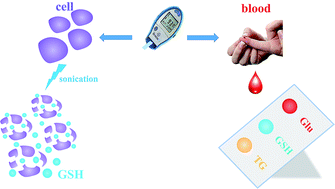Point-of-care monitoring of intracellular glutathione and serum triglyceride levels using a versatile personal glucose meter†
Abstract
Portable, cost-effective and quantitative detection of various targets related to health at home and in the field has the potential to revolutionize medical diagnostics. Despite years of research, only a few detection methods are available to the public. The most successful example is the personal glucose meter (PGM). We report the use of the PGM to detect reduced glutathione and triglyceride, which are biomarkers for some diseases. The method is based on target-induced consumption or production of nicotinamide coenzymes that has a linear relationship with the response of the PGM, thus establishing a direct correlation between the target concentration and the amount of nicotinamide coenzymes measured using the PGM. The detection limits of glutathione and triglyceride were 0.08 mM and 0.17 mM, respectively. More importantly, the assays were also successfully used for the detection of glutathione and triglyceride in practical samples, such as human serum and cells. In both assays, it's just a simple mixture of enzyme solution, which is easy to operate and apply. Such a method can be generally applied to a wide range of other targets using the corresponding enzyme reaction included nicotinamide coenzymes.

- This article is part of the themed collections: Analytical Methods Recent HOT articles and Celebrating our 2020 Prize and Award winners


 Please wait while we load your content...
Please wait while we load your content...